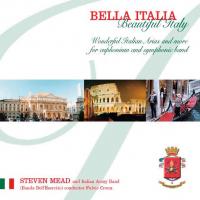'Mead reminds us about the art of playing a melody'
'Mead reminds us about the art of playing a melody'
Bella Italia CD Review
For several years euphonium virtuoso, Steven Mead, has been making regular visits to Italy and has built up a love affair with the country, its music and its bands. One happy outcome of this is a new CD, Bella Italia, featuring Steven and the Italian Army Band (La Banda Dell'Esercito), with its colourful conductor Lt.Col. Fulvio Creux. Not surprisingly, all 15 tracks have their origins in Italian music - predominantly operatic. Many of the pieces are relatively unknown and were chosen for their musicality rather than for their popularity.
The first track takes up themes from Donizetti's opera L'Elisir d'Amore. This was first performed in Milan in 1832 and, within five years, was available in Britain in a very early example of the operatic selection for brass band. Dulcamarata (Donizetti Variations) for Euphonium and Symphonic Band is an adaptation of a work for clarinet and band by the German-born theatre conductor and freelance composer Karl Heinz Koper, and is a fantasy based on themes from the opera, in which Dulcamarata takes the part of a 'quack' doctor. References to other themes also appear, including the familiar 'Napoli' and the Prelude to Wagner's Tristan und Isolde. This is no mere solo with band accompaniment; it lasts for almost 13 minutes, includes a beautiful section based on the opera's best-known piece 'Una furtiva lagrima', and establishes both soloist and band as being in the top class. It has many of the characteristics of a concerto, the band enjoying equal status with the soloist.
The heyday of the modern Italian opera was mainly in the 19th Century and was begun by Rossini, who wrote a staggering 40 operas between the years 1812 and 1829 - the year of William Tell. Rossini is not represented on this CD but his immediate successor Donizetti, provided the musical material for the first track. He, in turn , was followed by Bellini, nine years younger than Rossini and four younger than Donizetti. Bellini takes up four of the tracks, but two gems from earlier periods precede them.
The beautiful Caro mio ben was originally attributed to the Neopolitan composer, Guiseppe Giordani, but is now believed to be the work of his son, Tommaso. Although born in Naples in 1730, he spent much of his life in London, and would therefore be familiar with the music of Handel, in whose style this aria is written. Though few know of Tommaso Giordani these days, he wrote over 50 operas, many of them to English texts, before he died in Dublin in 1806. The well-chosen tempo and true Baroque style of playing make this piece one of the many gems on the CD. Pieta Signore, the second of the two older arias, though composed for performance in church, is not significantly different in style from the operatic aria. Attributed to Alessandro Stradella and, indeed, bringing fame to him, it is by no means certain than he was the actual composer. Its beauty and tenderness contrast sharply with the turbulent life of this somewhat wayward figure, involved in several scandals. He was murdered at the relatively young age of 37 when the brothers of one his mistresses hired an assassin to bring his philandering to an untimely end. Again, Mead and the Band portray the mood of this rather sombre aria excellently. It may be of interest to know that the Belle Vue test-piece of 1856 was an overture called Stradella that was in fact, from an opera by the German composer, Flotow (of 'Martha' fame), based on the life of Stradella. The mood lightens significantly with the first of the Bellini pieces not from opera but very much in an operatic style. Singing to the moon, the tormented lover in 'Vaga luna' anticipates Dvorak's infinitely better known aria by some 70 years. The other three Bellini arias are all from La Sonnambula (The Sleep Walking Girl), another work familiar to early bandsmen through the operatic selection. 'Vi ravviso, o luoghi ameni' and 'Ah, non credea mirarti' are both full of pathos and, in each Mead demonstrates sensitivity, with beautiful phrasing and immaculate intonation. The mood changes completely in the final extract from Sonnambula. This 'Ah, non guinge' forms the part of the opera's finale and, following several acrobatics in the high register the ending is obviously designed to bring the audience to its feet. Italian opera reached its high point with Verdi, represented here by three arias, two from La Traviata and one from the much later Otello. In 'A fors'e lui', the terminally ill Violetta soliloquises about her love for Alfredo. Later in the opera, in 'Di Provenza il Mar', Alfredo sings of his despair on finding that Violetta has abandoned him. Otello, based on Shakespearse's tragedy, is full of intrigue, hatred and murder. Despite all, the 'Ave Maria' sung by the ill-fated Desdemona is an aria of great beauty and serenity receiving a heart-felt performance here by Mead and the Italian Army Band.
Puccini arrived on the scene 45 years after Verdi and took Italian opera into the 20th Century. Tosca was first performed in Rome in 1900 and its 'Vissi d'arte', known in its English translation as 'Love and Music', demonstrates Puccini's great gift of melody and proves most effective as a euphonium solo.
Next comes Enrico Toselli's 'Serenata'. In its setting of 'Like a Golden Dream', it is the one piece by which this composer is now chiefly known. In contrast, neither Francesco Feliciangeli nor his opera Lo Scudiero del Re are likely to be known at all to the majority of British listeners. Though composed in the 20th Century, its style is undoubtedly of the 19th and it sits well in this collection, again giving Mead an opportunity to demonstrate his command of the upper register.
Following this splendid collection of vocal pieces transcribed for the euphonium, the CD returns to the instrumental idiom for the final two tracks. Giovanni Orsomando was dubbed 'The Godfather of Italian Band Music' (possibly because he conducted Mussolini's Presidential Band, Le Band del Duce, from 1938-43). His Alla Czardas, originally for clarinet and band, has been adapted as euphonium solo by Fulvio Creux, who also adds a highly spectacular cadenza, taking Mead up to a super-A, almost an octave higher than lesser mortals are expected to achieve. It is similar, in many ways, to the more famous Monti's Czardas - a czardas being a type of Hungarian dance. Here is a superb vehicle for Mead's incredible virtuosity.
The CD began with the Donizetti Variations and, giving it a symmetrical shape, turns to that most popular of all sets of variations, Carnival of Venice, for its finale. The well-known Arban version is here enhanced by the celebrated band arrangement of Donald Hunsberger, giving both soloist and band a great time - obviously relished by both in this definitive performance.
This is a CD with a difference. Whilst not without its virtuosic moments, it also proves that the art of melody playing is not yet dead. Many of our younger players would do well to listen to Steven Mead - in particular his phrasing, his expression and the manner in which he achieves the many changes of mood. For those interested only in musical fireworks this would probably not be the ideal Christmas present , but if your priority is music, go out and buy it, now !
Dr. Roy Newsome - British Bandman Magazine 10 July 2004

Steven Mead and the Italian Army Band (Banda dell'Esercito)

